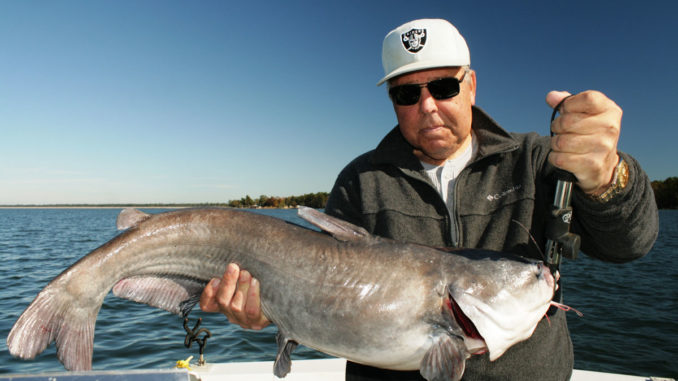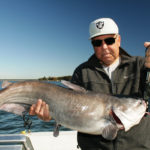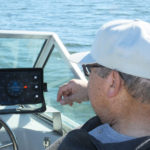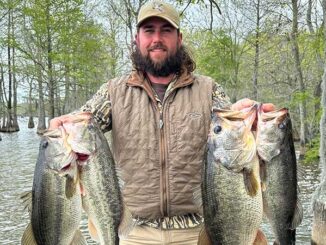
High-Tech isn’t always necessary for fishing
When guide Bob Winters stowed his gear after a day of fishing on Lake Moultrie, I caught myself wandering around his old Glassmaster boat, checking out the ancient flasher sonar unit. I recognized it because I’d used one myself long ago.
“I’m an ‘old-school’ fisherman,” Winters said. “You won’t see much high-tech equipment on my boat; I do a lot of things the old-school way.”
Winters, 73, who works out of Blacks Camp on the Diversion Canal between the Santee Cooper lakes, has guided professionally since 1979. His heyday dates to the golden years when stripers were king and the big catfish had exploded onto the Santee Cooper scene. Winters was one of the iconic guides from the era when names like Joe Drose, “Big” John Sellers, John “Roundtrip” Ham, Tom Thaxton and others were making Lake Moultrie and Lake Marion household words to the national fishing community.
Winters said he prefers old-school qualities about most things.
“I’ve got a 1988 Glassmaster boat pulled by a 1994 Ford truck,” he said. “I have what many consider an ancient Lowrance 2460 flasher as my electronic equipment. And to stay consistent; I have a 1968 John Deere tractor and a wonderful, 1960-model wife.”
Winters (843-700-0626) said the fishing on the Santee Cooper lakes is excellent for catfish and stripers, even in the middle of winter.
“From mid-December through mid-January — and often beyond — both species are caught in big numbers and sizes,” he said. “It’s prime time.”
Winters said fish tend to orient to deep water, and fishing near forage, often threadfin or gizzard shad, is crucial.
“I use my flasher to find the hills, drops and channels,” he said. “But I enhance that with a lifetime of fishing knowledge. I know where fish typically are at different times of the year, and with my flasher, I spot forage and mark suspended stripers as well as catfish on the bottom.”
Winters said his commitment to the flasher is so strong he has multiple backup plans.
“I have three more 2460s tucked away in case this one gives out, and two Hummingbird Super Sixties as my fallback when those are gone,” he said.
The menhaden factor arrives
But the arrival of menhaden as a forage source also impacts winter fishing patterns.
“When menhaden are available, they become the primary forage,” he said. “I’ll fish for suspended fish relating to the menhaden schools when and if they move in.”
Until menhaden arrive, Winters prefers to drift flat stretches of bottom with live gizzard shad or blueback herring for stripers and targets the depths fish are marked on his depth finder. For catfish, he drifts hills and ledges using the Santee catfish rig with gizzard shad or herring as bait. But he doesn’t use a circle hook for either species.
“I’m old school on hooks, too,” he said. “I’ve tried circle hooks but prefer a standard 6/0 Eagle Claw hook for catfish and the 1/0 size for stripers. One reason is circle hooks frequently foul into the bait, and my regular hooks don’t.”
As for interpreting what’s depicted on his old flasher unit, Winters hit a homerun on his first attempt. While drifting up a ledge from deep to shallower water — his preferred way to drift a catfish hot spot — he marked a momentary flash just off the bottom on the screen.
“That’s a good fish; we ought to catch that one,” he said.
Calculating the amount of line out and drift rate, some of the baits would arrive at ground zero in less than two minutes. Ninety seconds, later the rod was snatched three eyes deep into the water, and a big catfish was solidly hooked.
Winters isn’t opposed to new technology, he’s tried most of it before opting back to old-school methods.
“I stay open-minded thanks to my son, Bobby,” he said. “He’s 23 and graduated college in December 2017 and is considering guiding as a profession. He likes new technology, and it clicks for him.”
Don‘t be fooled the old-school philosophy, Winters’ fish-catching standards are the same as any Santee Cooper guide.
“At the end of the day, we all want the same thing: to provide folks with great fishing,” he said. “Whether that goal is a box full of fish or just a day of catch-and- release, the bottom line is, fishermen enjoying the experience and catching fish. I’ve experimented with a lot of techniques and equipment and simply use the ones that work best for me.”
He made the analogy that at the end of the day a box of fish in 2018 is remarkably similar to a box of fish in 1979, when today’s “old school” was the new technology. Winters learned it well and still fills coolers today.







Be the first to comment